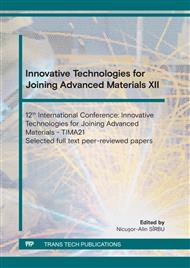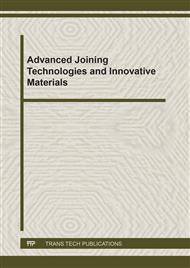[1]
http://www.automobile-steel.com/Automotive-steel/EN-10111-DD13.html.
Google Scholar
[2]
B K Panigrahi Bull, Processing of low carbon steel plate and hot strip-an overview, Mater. Sci., Vol. 24, No. 4, Aug. 2001, p.361–371, © Indian Academy of Sciences.
DOI: 10.1007/bf02708632
Google Scholar
[3]
https://matmatch.com/materials/minfm35158-en-10111-grade-dd13-hot-rolled.
Google Scholar
[4]
http://www.steel-plate-sheet.com/Sellinglist/EN-10111-DD13-steelDD13-steel-Application.html.
Google Scholar
[5]
http://www.steelnumber.com/en/steel_composition_eu.php?name_id=220.
Google Scholar
[6]
https://melindasteel.ro/table-din-otel/74-tabla-laminata-la-cald-3.html#.
Google Scholar
[7]
https://www.salzgitter-flachstahl.de/fileadmin/mediadb/szfg/informationsmaterial/produktinformationen/warmgewalzte_produkte/eng/dd13.pdf.
Google Scholar
[8]
https://chermk.severstal.com/upload/iblock/7de/7de1285a875ceedbb961ed8da249b55d.pdf.
Google Scholar
[9]
J. Mucha, L. KaščáK, E. Spišák, Joining the car-body sheets using clinching process with various thickness and mechanical property arrangements, Archives of Civil and Mechanical Engineering,.
DOI: 10.1016/s1644-9665(12)60179-4
Google Scholar
[10]
E. Spišák, L. Kaščák, J. Slota, Strength analysis of joints made with resistance spot welding and press joining, Acta Mechanica Slovaca, Vol. 7, No. 2, 2003, p.45–50.
Google Scholar
[11]
K.G. Kerschbaumer, R. Vallant, N. Enzinger, C. Sommitsch, Welded Aluminium And Magnesium Alloys – Corrosion And Mechanical Properties For Refrigeration Compressors In Comparison With Deep-Drawing Steel, ISSN 1580-2949 /Izvirni znanstveni ~lanek MTAEC9, 47(3)363(2013).
Google Scholar
[12]
DVS 0913, DVS Merkblatt 0913, Deutscher Verband der Schweißtechnik, Düsseldorf (1994).
Google Scholar
[13]
Böhler welding, Wissenswertes für den Schweißer, Kapfenberg 09/2010, 2–28.
Google Scholar
[14]
B. Radu, a.o., Innovative, environmentally friendly and efficient technologies for joining of metallic and polymeric materials for the automotive industry, using the friction stir welding technique (Inova-FSW), Project 219/(2014-2017), Program Partnerships in priority areas.
Google Scholar
[15]
X.C. Liu and C.S. Wu, Elimination of tunnel defect in ultrasonic vibration enhanced friction stir welding, Materials and Design, https://doi.org/10.1016/j.matdes.2015.10.131, vol.90, Jan.2016, pp.350-358.
DOI: 10.1016/j.matdes.2015.10.131
Google Scholar
[16]
B. Strass, G. Wagner, C. Conrad, B. Wolter, S. Benfer and W. Fuerbeth, Realization of Al/Mg-Hybrid-Joints by Ultrasound Supported Friction Stir Welding - Mechanical Properties, Microstructure and Corrosion Behavior, Advanced Materials Research 06/2014; 966-967:521-535, https://doi.org/10.4028/www.scientific.net/AMR.966-967.52.
DOI: 10.4028/www.scientific.net/amr.966-967.521
Google Scholar
[17]
X.C. Liu, C.S. Wu and G.K. Padhy, Improved weld macro section, microstructure and mechanical properties of 2024Al-T4 butt joints in ultrasonic vibration enhanced friction stir welding, Proceedings of IMECE2008 2008 ASME Int. Mech. Engineering Congress and Exposition 31.10-6.11.2008, Boston, Massachusetts USA, Science and Technology of Welding&Joining, June 2015, https://doi.org/10.1179/1362171815Y.0000000021.
DOI: 10.1179/1362171815y.0000000021
Google Scholar
[18]
K.H Park, B. Kim and J. Ni, Numerical simulation of plunge force during the plunge phase of friction stir welding and ultrasonic assisted FSW IMECE2008-67002, pp.237-242; https://doi.org/10.1115/IMECE2008-67002.
DOI: 10.1115/imece2008-67002
Google Scholar
[19]
K. Park, G.Y. Kim and J. Ni, Design and Analysis of Ultrasonic Assisted Friction Stir Welding, IMECE2007-44007, pp.731-737, https://doi.org/10.1115/IMECE2007-440077.
Google Scholar
[20]
Y. B. Zhong, C.S. Wu and G.K. Padhy, Effect of ultrasonic vibration on welding load, temperature and material flow in friction stir welding, Journal of Materials Processing Technology, Vol.239, Jan.2017, Pp.273-283, https://doi.org/10.1016/j.jmatprotec.2016.08.025.
DOI: 10.1016/j.jmatprotec.2016.08.025
Google Scholar
[21]
O. Oancă, N.A. Sîrbu, a.o, Non-conventional hybrid techniques and technologies of joining materials for industrial applications, National Research Project PN 18 33 01 01 Nucleu Program ISIM Timisoara, Romania (2018).
Google Scholar
[22]
G.V. Mnerie, E.F. Binchiciu, O. Oancă, a.o., FSW-US Hybrid Process Joining of Engineering Materials, Key Engineering Materials, ISSN 1662-9795, Vol.890, pp.47-55, (2021).
DOI: 10.4028/www.scientific.net/kem.890.47
Google Scholar



